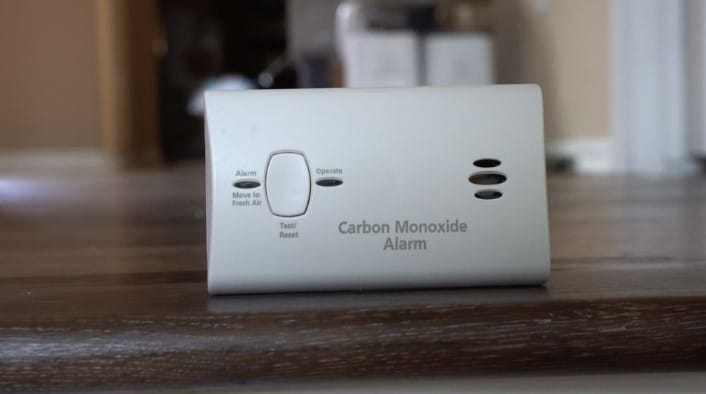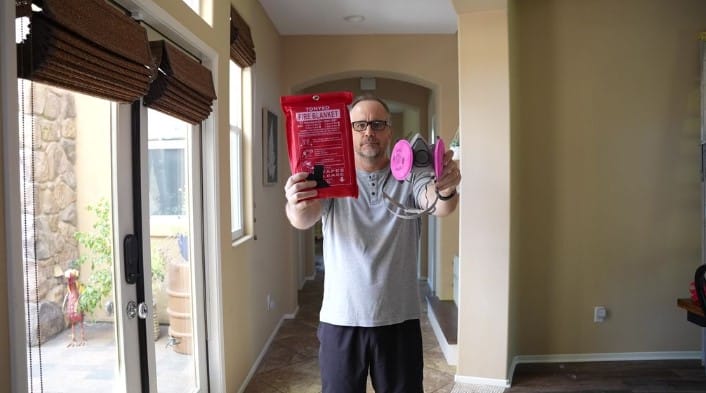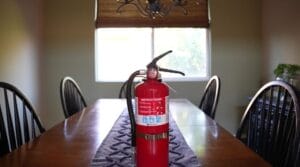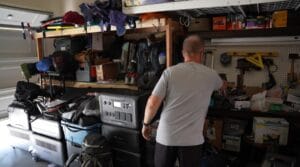- KNOW WHEN THERE IS A FIRE
 Your first line of protection is awareness. We often think of fires as being big and bright. But, they can actually smolder for days inside walls, hidden from sight, all the while burning up oxygen and releasing carbon monoxide that can kill you in your sleep. Make sure you have smoke detectors on every level of your home, and then test them every month, not just when they are chirping. Additionally, be sure to have carbon monoxide detectors on every floor of your home located within 10 feet of each bedroom door. Some devices can even alert your phone if you are away from home or sleeping. Smoke alarms last about ten years, so if it has been a while since you replaced them, consider this your chance for a complete fire safety overhaul of your home.
Your first line of protection is awareness. We often think of fires as being big and bright. But, they can actually smolder for days inside walls, hidden from sight, all the while burning up oxygen and releasing carbon monoxide that can kill you in your sleep. Make sure you have smoke detectors on every level of your home, and then test them every month, not just when they are chirping. Additionally, be sure to have carbon monoxide detectors on every floor of your home located within 10 feet of each bedroom door. Some devices can even alert your phone if you are away from home or sleeping. Smoke alarms last about ten years, so if it has been a while since you replaced them, consider this your chance for a complete fire safety overhaul of your home.
- GET OUT
 Fires spread fast. In mere seconds they can grow so large that they consume all the breathable air and kick up so much toxic smoke that surviving becomes difficult. Studies show that once a house fire starts, you have at most two to three minutes to leave. Know the basics of fire safety, like feeling a door to ensure it’s not hot before you open it and staying low to the ground. Also, have a plan for each person. Have them draw out a map so it’s implanted in their brain. Make sure each person has more than one means of escaping. That may require having a fire escape ladder from the second or higher floor. Practice escaping from your home at least twice a year.
Fires spread fast. In mere seconds they can grow so large that they consume all the breathable air and kick up so much toxic smoke that surviving becomes difficult. Studies show that once a house fire starts, you have at most two to three minutes to leave. Know the basics of fire safety, like feeling a door to ensure it’s not hot before you open it and staying low to the ground. Also, have a plan for each person. Have them draw out a map so it’s implanted in their brain. Make sure each person has more than one means of escaping. That may require having a fire escape ladder from the second or higher floor. Practice escaping from your home at least twice a year.
- SAVE YOUR CRITTERS
 Most people have no plan for their pets in a crisis. Remember your pets, but it’s not worth your life if they are too panicky or hiding in a burning house. Leaving a door open for them is usually enough for them. When they are scared enough, they’ll run out on their own. A well-trained animal should listen to your voice and come if called. Of course, not all animals will. Remember, getting away from a fire is your best chance of surviving.
Most people have no plan for their pets in a crisis. Remember your pets, but it’s not worth your life if they are too panicky or hiding in a burning house. Leaving a door open for them is usually enough for them. When they are scared enough, they’ll run out on their own. A well-trained animal should listen to your voice and come if called. Of course, not all animals will. Remember, getting away from a fire is your best chance of surviving.
- FIRE EVACUATION MASK & BLANKET
 I highly recommend a fire evacuation mask and a fire blanket. 80% of home-fire-related deaths are due to smoke inhalation. The mask will give you some breathable air if it’s a respirator type or filtered air if cloth. The cloak can protect you from heat and burns on your way out. Remember, fires pull oxygen from the air, which a mask can not address, but they can protect you from smoke inhalation. There are even some filters on the market, as shown here, that can scrub carbon monoxide from the air for a short enough period of time to allow you to escape safely.
I highly recommend a fire evacuation mask and a fire blanket. 80% of home-fire-related deaths are due to smoke inhalation. The mask will give you some breathable air if it’s a respirator type or filtered air if cloth. The cloak can protect you from heat and burns on your way out. Remember, fires pull oxygen from the air, which a mask can not address, but they can protect you from smoke inhalation. There are even some filters on the market, as shown here, that can scrub carbon monoxide from the air for a short enough period of time to allow you to escape safely.
- FIREPROOF DOCUMENT BAG
 If you have time to grab this on your way out of the house, great. If you don’t, at least your documents are likely to survive if the fire department arrives quickly enough. Birth certificates, IDs, passports, and even expired ones can help you rebuild after a devastating fire. Insurance documents and old utility bills will help you re-establish after a fire. An emergency cash envelope or a credit card tucked away can give you the funds you need to stay in a hotel until the fire damage can be assessed. These make great additions to the Bug out bags you already have established. If you also put in our FREE Disaster Plan Guide, you will have the information you need when you need it.
If you have time to grab this on your way out of the house, great. If you don’t, at least your documents are likely to survive if the fire department arrives quickly enough. Birth certificates, IDs, passports, and even expired ones can help you rebuild after a devastating fire. Insurance documents and old utility bills will help you re-establish after a fire. An emergency cash envelope or a credit card tucked away can give you the funds you need to stay in a hotel until the fire damage can be assessed. These make great additions to the Bug out bags you already have established. If you also put in our FREE Disaster Plan Guide, you will have the information you need when you need it.
- MEET-UP
 Make sure you have a rallying point away from your home where you can do a quick headcount to ensure everyone got out safely. If this is a structure away from the house, like a tool shed or your vehicle, ensure there are shoes and basic clothes for everyone, as your family may have had to leave the house in a half-dressed hurry. This is why having an emergency bug-out bag or go bag is so important. Also, establish a family emergency communications plan and ensure that all household members know who to contact if they cannot find one another.
Make sure you have a rallying point away from your home where you can do a quick headcount to ensure everyone got out safely. If this is a structure away from the house, like a tool shed or your vehicle, ensure there are shoes and basic clothes for everyone, as your family may have had to leave the house in a half-dressed hurry. This is why having an emergency bug-out bag or go bag is so important. Also, establish a family emergency communications plan and ensure that all household members know who to contact if they cannot find one another.
- FIRE EXTINGUISHERS
 Minimally, you should have an extinguisher and/or a fire blanket in the kitchen or next to a wood stove or a fireplace, as these are the most common places fires start in homes. Make sure your kitchen extinguisher can snuff out a grease fire. It must be a class B, BC, or ABC fire extinguisher. Check the gauge on the fire extinguishers on an annual basis to ensure it’s still at the correct levels. You may consider setting a reminder using a tool like Google Calendar to remind yourself.
Minimally, you should have an extinguisher and/or a fire blanket in the kitchen or next to a wood stove or a fireplace, as these are the most common places fires start in homes. Make sure your kitchen extinguisher can snuff out a grease fire. It must be a class B, BC, or ABC fire extinguisher. Check the gauge on the fire extinguishers on an annual basis to ensure it’s still at the correct levels. You may consider setting a reminder using a tool like Google Calendar to remind yourself.
- UNPLUG & DISCONNECT
 If it’s an electrical fire, you may be able to unplug the fire source. If the electrical fire is at the plug, don’t attempt this. You should also know how to turn the main power at your breaker box. If you can safely disconnect an electrical fire, it will reduce the risk of it growing. When the fire department does arrive, they will disconnect any utilities until the home is deemed enterable again.
If it’s an electrical fire, you may be able to unplug the fire source. If the electrical fire is at the plug, don’t attempt this. You should also know how to turn the main power at your breaker box. If you can safely disconnect an electrical fire, it will reduce the risk of it growing. When the fire department does arrive, they will disconnect any utilities until the home is deemed enterable again.
- KITCHEN FIRES
 As mentioned in a prior point, most home fires start in the kitchen. In addition to a fire extinguisher under the sink, I always keep a large box of baking soda in the kitchen cabinet near the stove. Stay in the kitchen when frying, grilling, simmering, baking, roasting, or boiling food. A fire blanket that can be tossed over the fire is another option. In case of a fire outbreak in a pan, while cooking, it is advisable to immediately turn off the burner and cover the burning pan with a lid. Keeping the lid in place until the pan is completely cooled is crucial to avoid spreading the fire or causing any injuries by moving the pan. It’s important to note that pouring water on grease fires should be avoided at all times.
As mentioned in a prior point, most home fires start in the kitchen. In addition to a fire extinguisher under the sink, I always keep a large box of baking soda in the kitchen cabinet near the stove. Stay in the kitchen when frying, grilling, simmering, baking, roasting, or boiling food. A fire blanket that can be tossed over the fire is another option. In case of a fire outbreak in a pan, while cooking, it is advisable to immediately turn off the burner and cover the burning pan with a lid. Keeping the lid in place until the pan is completely cooled is crucial to avoid spreading the fire or causing any injuries by moving the pan. It’s important to note that pouring water on grease fires should be avoided at all times.
- PUT IT OUT
 If you are unsure of the average response time of your local fire department, you may want to ensure you have some means of fighting the fire from the exterior of your home. This is very important if you live in an area prone to wildfires. If you have a pool, hot tub, or pond, a water pump can let you fight the fire or wet down the roof and landscaping for protection from an approaching fire. Never enter a burning structure. Even if it looks safe, the air could be toxic and kill you in seconds. With a pump and hose setup, though, you could break a window and pump water on any fire in your home. Even with this fire-fighting measure, keep a safe distance from the fire and don’t attempt to fight the fire if there is any risk of explosions or smoke inhalation.
A hurricane, tornado, flood, or civil unrest may never threaten your home, but fire is always possible. A burner left on the stove, a candle, faulty wiring, or a careless neighbor are all possibilities. Because of this, you must protect yourself from that genuine possibility. Develop and implement a plan and watch this video again, if you have to, to ensure you have covered all ten simple ways to protect yourself. After you have done that, share this video and blog with someone you care about. The life you save in those critical moments may be your own or someone you love.
As always, stay safe out there.
LINKS:
FREE Disaster Plan Guide – https://courses.cityprepping.com/disaster-guide-opt-in-page/
Firebag: https://amzn.to/3WyXmmO
Carbon monoxide filter: https://cityprepping.tv/45OkEcw along with Gas Mask: https://cityprepping.tv/45Mpozo
If you are unsure of the average response time of your local fire department, you may want to ensure you have some means of fighting the fire from the exterior of your home. This is very important if you live in an area prone to wildfires. If you have a pool, hot tub, or pond, a water pump can let you fight the fire or wet down the roof and landscaping for protection from an approaching fire. Never enter a burning structure. Even if it looks safe, the air could be toxic and kill you in seconds. With a pump and hose setup, though, you could break a window and pump water on any fire in your home. Even with this fire-fighting measure, keep a safe distance from the fire and don’t attempt to fight the fire if there is any risk of explosions or smoke inhalation.
A hurricane, tornado, flood, or civil unrest may never threaten your home, but fire is always possible. A burner left on the stove, a candle, faulty wiring, or a careless neighbor are all possibilities. Because of this, you must protect yourself from that genuine possibility. Develop and implement a plan and watch this video again, if you have to, to ensure you have covered all ten simple ways to protect yourself. After you have done that, share this video and blog with someone you care about. The life you save in those critical moments may be your own or someone you love.
As always, stay safe out there.
LINKS:
FREE Disaster Plan Guide – https://courses.cityprepping.com/disaster-guide-opt-in-page/
Firebag: https://amzn.to/3WyXmmO
Carbon monoxide filter: https://cityprepping.tv/45OkEcw along with Gas Mask: https://cityprepping.tv/45Mpozo 
